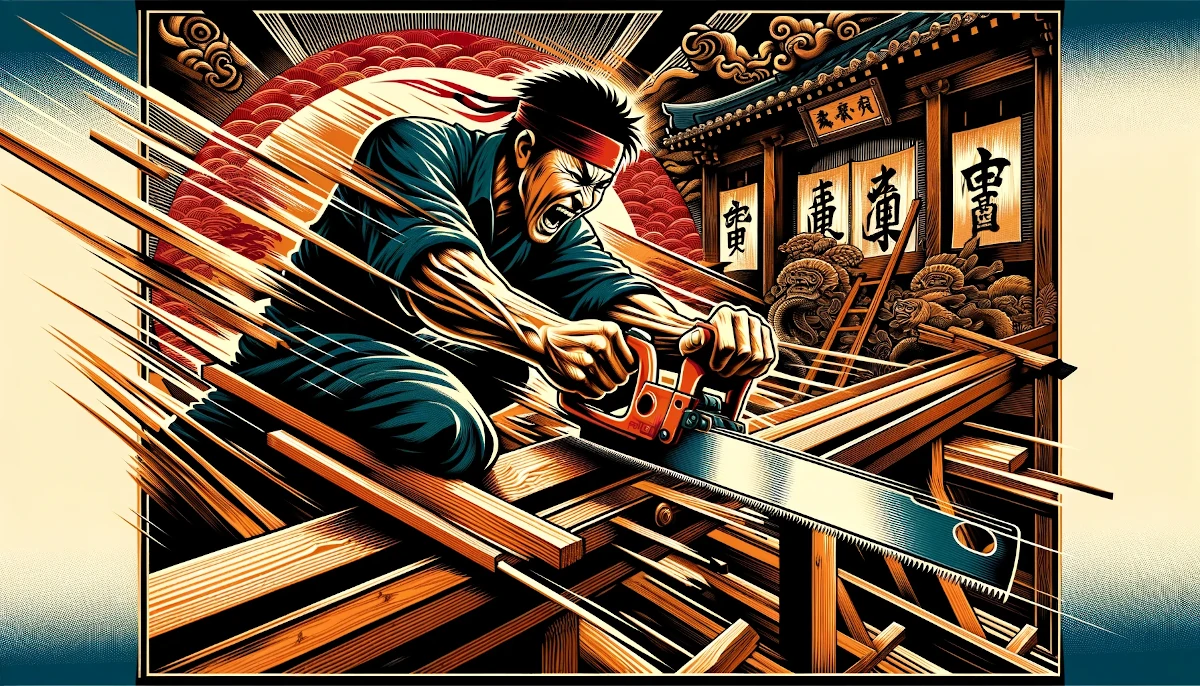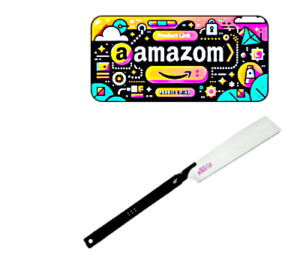In this session, we’ll thoroughly explain how to use Japanese saws, specially designed for carpentry. With the rise of power tools, the use of handsaws has decreased. However, while power saws are efficient, they also pose significant risks and are less forgiving of mistakes, requiring careful practice and a long learning period. Surprisingly, honing your handsaw skills can enhance your proficiency with a circular saw.
Professional Japanese craftsmen will provide a detailed guide on how to use these Japanese handsaws. By the end of this article, your woodworking skills will undoubtedly have advanced to a new level.
日本語版の記事(鋸(ノコギリ)の使い方【プロが解説】丸ノコを使う前に覚えよう)はコチラ
List of Contents
Article Author

Kentarou Fukata
A Kyoto, Japan native born in 1985, I am a seasoned carpenter boasting five national qualifications in housing-related disciplines in Japan. Committed to the dissemination of carpentry expertise, I actively contribute to professional development within the field through instructional content on YouTube.
Introduction Video
Complementing the guide is an informative video designed to augment comprehension.
If you wish to utilize features like subtitles, please reopen the video on YouTube. You can access the subtitles through the ‘CC’ button on the playback screen or in the settings.
Three Characteristics of a Handsaw

Understanding the characteristics of a tool enables 100% proficiency and efficient mastery.
Handsaws are seldom needed on their own
In current woodworking, various machines like circular saws, multi-tools, and reciprocating saws are used for cutting wood. In environments where machines are available, hand tools can’t compete in speed and accuracy, reducing their usage. However, compared to the aforementioned power tools, handsaws are significantly safer, allow for unique cuts not possible with other tools, and not knowing how to use a handsaw limits your options in those scenarios.
Essential for Mastering Carpentry Skills
For those aspiring to master carpentry, proficiency in using a handsaw is indispensable. Handsaws continue to be instrumental for tasks unachievable with power tools. Particularly, handling a handsaw can significantly differentiate one’s skill level and impact the duration of tasks. Moreover, since handsaw skills complement those of power tools, the inability to use a handsaw could substantially influence your proficiency with power tools.
Affordable Replacement Blades
Recently, there has been an increase in the use of handsaws with replaceable blades among professional carpenters. Similar to utility knives, the low cost of replacement blades for handsaws allows users to make cuts that would otherwise compromise sharpness while keeping cost-related damage to a minimum. For example, when there are nails in the cutting area, a less expensive handsaw blade is utilized. If cutting through nails is inevitable, using only the tip of the blade to make cuts near the nails can minimize damage to the blade.
Explanation of the Japanese Saw Blade Design

The mechanism of Japanese saw blades
Japanese hand saws are designed to cut on the pull stroke
Japanese hand saws are made to cut the wood when pulled. The reason for this is to allow delicate adjustment of the cut surface by aligning the blade with the cutting line while pulling. Also, as force is applied during the pull, it reduces the strain on the blade, allowing the use of thinner blades and achieving delicate cuts with a light cutting feel.
Friction Reduction Feature ‘Asari’
The blades of Japanese hand saws have teeth set alternately bent outward. The difference between the thickness of the blade and the extent to which it is bent outward is called ‘asari.’ This creates a gap between the blade and the wood, reducing friction during use.
*Note: While replaceable blades are now the norm for Japanese hand saws, decades ago, saw craftsmen individually hammered and adjusted the ‘asari’ for each blade.
Blade Shapes Tailored to the Direction of Wood Fibers
Handsaw blades are available in different shapes depending on the direction of the wood fibers to be cut, and users choose accordingly. For ‘ripping’ along the wood fibers, the blade teeth are flat like chisels to shave the longitudinal fibers. For ‘cross-cutting’ across the wood fibers, the blade teeth are pointed like knives to sever the fibers.
*Note: A Japanese double-edged handsaw refers to a handsaw that features both these blade shapes on opposite sides.
Regarding Handsaw Sizes and Types
Japanese saws, even just those for carpentry, come in various sizes tailored to specific uses. The size is indicated by the length of the blade, and as the length increases, the blade thickness and each tooth size proportionally increase. While the common type has a simple, flat blade, there are also ‘guided saws’ used for delicate tasks, which have a series of fine teeth on a thin blade supported by a guide.
*Note: In the past, all handsaw blades were made of steel, but nowadays, the replaceable blade types available at affordable prices are made of ordinary iron, with only the tips hardened by a chemical treatment.
Shape of the Handle on Japanese Saws
Japanese hand saws are equipped with long handles. This design allows for the saw to be held with both hands and maneuvered in front of the body, greatly enhancing the speed and accuracy of sawing. For this reason, Japanese carpenters generally do not use saws with short handles.
*Note: Although long handles can sometimes be cumbersome, there are also saws with shorter or pistol-grip handles available on the market for those who prefer them.
Unlocking the intrinsic performance of the saw
Maximizing the inherent capabilities of the saw
Using the entire length of the blade
With handsaws, utilizing the entire blade allows for the maximum amount of cutting per stroke.
For delicate cuts, minimize hand tremors and smoothly draw the saw for an extended duration.
Efficient Cutting with Extended Handle Use
The fundamental approach to cutting wood involves operating the saw with both hands directly in front of your body. This technique allows for a clear view of both the cutting line and the saw’s path while enabling a powerful pull using your core muscles. The long handle facilitates two-handed operation, ensuring delicate and swift cutting. While intricate tasks may sometimes necessitate one-handed operation, mastering the correct stroke with both hands ensures precise strokes even in unstable situations.
Applying Force While Pulling
Japanese handsaws are designed for pulling cuts. When you want to cut quickly, it’s more effective to apply force in the desired direction while pulling. Since the saw cuts faster with more force applied, quick cutting requires physical strength.
Ideally, lift the blade slightly when returning it to the starting position. During rapid cutting, this return stroke tends to get rushed and careless, potentially leading to blade bending or breaking.
Cutting Straight
Japanese saws are exclusively crafted for creating flat surfaces and cannot make curved cuts. Envision cutting forward with the plane of the saw blade. Naturally, the plane is set at the beginning of the cut, and it cannot be adjusted afterward. Therefore, the initial stroke is extremely crucial.
*For shaping curved surfaces, please use other tools.

Enhancing Precision
Visibility of the cutting surface and posture.
When using a handsaw, it is imperative to maintain a clear line of sight between the saw blade and the cutting line. The process of cutting wood typically commences at the wood piece’s corner. Tracing the front cutting line from the corner is fairly straightforward, allowing for easy adjustments by pulling toward oneself. Nevertheless, tracing the back cutting line is equally vital.
For precise cutting, it’s crucial to align the plane of the saw blade with the plane created by both the front and back cutting lines. This involves keeping both the saw blade and the cutting line in your field of vision during cutting, ensuring consistent strokes. To achieve this, one must adjust their body’s position and angle in relation to the cutting surface, always maintaining a posture that keeps the saw straight and in front of the body.
Mastering this skill will substantially improve your proficiency with a circular saw as well.
Using a ruler
Just like with a circular saw, employing a ruler can enhance cutting efficiency when using a handsaw. The method involves aligning a piece of wood as a ruler along the cutting line and then beginning the cut by guiding the saw blade along it.
When using a handsaw for precise cuts, such as the abutment parts of finishing materials, the surface on the front side tends to get rough due to the blade pulling out. However, using a ruler can prevent this roughness by holding down the surface being pulled out, resulting in a clean and smooth finish.
Note that wooden rulers are prone to damage and loss of precision from the saw’s teeth, necessitating their frequent replacement.
Align the Cutting Line While Pulling
When initiating a cut, aim to trace the cutting line while in a pulling state as much as possible. As previously noted, tracing the back side is essential, yet if you can alter the direction of the cut, positioning the longer side of the cutting line towards you simplifies the start of the cut. While this may seem trivial, such details can significantly impact the outcome and shouldn’t be overlooked. Even in complex scenarios, like aligning cuts on more than three surfaces, rotating the wood and aligning from the back to the front can make setting the cutting surface much more manageable.
*Guide Saws: A Limited Role
In the past, guide saws were employed for precision-demanding tasks like flush cuts. However, mastering these saws required high skill and extensive practice. Nowadays, such tasks can be accomplished using power tools like the sliding miter saw. While crafting delicate joinery with power tools is not straightforward, prioritizing proficiency with the sliding miter saw over the guide saw is more practical.
Essentials for Speeding Up Processing

Cut with all your might and passion!
In woodworking, the goal is to carve quickly and accurately. When using a handsaw, power is crucial for rapid processing. While increasing efficiency can significantly boost the speed of chiseling with a wood chisel, the processing speed with a handsaw is directly proportional to the pulling force and speed.
Remember, imprecise cuts are meaningless, so aim for a balanced approach—cut meticulously yet boldly.
Finishing the Cut in One Go
Professional carpenters place paramount importance on completing the finish work in a single cut when it comes to woodworking. The goal, even when using a handsaw, is to refine your skills to achieve a finish cut in just one go, rather than making a preliminary cut. This approach is crucial because correcting a surface after a preliminary cut can take more than double the time compared to executing a clean cut in a single attempt.
Skilled craftsmen may seem to work slowly, but they miraculously complete their work quickly and flawlessly. This capability is due to their proficiency in this particular aspect of their craft.
Efficient Practice Methods

Mastering the handsaw is best achieved through hands-on experience and practice. Below are key points to focus on during your practice. For those who don’t use a saw regularly, take any opportunity on a free day to practice cutting unused wood.
Learn the timing for exerting force with your body
You can make accurate and powerful strokes with a handsaw by effectively using your core muscles. To engage your core, maintain a posture where your shoulder axis and pelvic axis are aligned without twisting, and engage your inner muscles. *Note: The inner muscles tighten up above your navel when you exhale fully.
Try practicing in various postures and situations, including difficult angles and heights, and consider different scenarios (blade types) to adapt to.
Training the Biceps and Abdominal Muscles
Using a handsaw typically involves pulling with both hands to ensure precise and forceful strokes. The muscles engaged while using a handsaw are similar to those used when planing, primarily the biceps and abdominal muscles. As these might be muscles you don’t usually use, initially, this can feel like an intense workout. However, consider it a bonus to sculpt a toned and attractive physique while you’re at it!
What You Can Do Specifically with a Handsaw

In this section, we’ve summarized what can be uniquely achieved with a handsaw compared to power tools, and the tasks for which a handsaw should be specifically employed.
Tasks where power tools can’t cut (or are too slow)
There are situations where a handsaw is the only option due to the limitations of power tools. However, to truly understand the strengths of a handsaw, it’s also essential to be familiar with the characteristics of power tools.
When Power Tools Pose a Risk
Circular saws are among the most hazardous tools in carpentry. In the realm of craftsmanship, an injury defeats the purpose of creation. Therefore, for dangerous tasks, even if it takes a bit more time, opt for the safety of cutting with a handsaw.
Tools Have Specific Cutting Depths
The cutting depth of a standard circular saw is around 60mm, and for a multi-tool, it’s about 50mm. If any part remains uncut, it’s necessary to choose another cutting tool like a handsaw that can handle the depth.
Circular Saws Struggle with Thin Materials (Like Resin)
In woodworking, there are times when you need to cut materials other than wood, such as plastic or other resin-based materials. Cutting thin resin products, approximately 2mm thick, poses a risk of shattering the material when using a circular saw, making it an unsuitable tool for the task. In such instances, it’s advisable to use a handsaw with a blade specifically designed for cutting resin, even when using a handsaw.
Multi-Tools are Convenient but Slow
Multi-tools are incredibly versatile, capable of cutting in situations where other tools might fail. However, it’s common to see people becoming overly reliant on their convenience, forgetting that multi-tools actually have lower cutting power and tend to be slower in cutting. When compared with handsaws, handsaws can cut overwhelmingly faster. Therefore, it’s crucial to carefully assess the situation and choose the most suitable tool for the job.

Hand Tools are Handy for Light Tasks
During work on scaffolding, the convenience of portable hand tools becomes particularly valuable. Even though the use of rechargeable tools has increased recently, these tools share the same weight and heightened risk of damage if dropped as their corded counterparts. Hand tools are especially useful for light tasks or when you need to transport both the tool and the materials being installed.
About Replaceable Blade Saws

The handsaw is an uncommon tool that has completely shifted to replaceable blades.
Why the transition?
Let’s delve into the differences between replaceable and traditional hand-forged saws. The sharpness of hand-forged, hand-sharpened saws tends to be superior, offering a deep penetration into the wood.
Regarding the price, traditional handsaws were quite expensive, as they were handcrafted by artisans. In contrast, replaceable blades can be bought for around 300 yen, making them substantially more affordable.
In terms of precision, new replaceable blades, being industrial products, offer high accuracy. However, hand-sharpened blades were known to have slight inconsistencies.
Regarding the material, replaceable blades made of iron bend easily, while hand-forged saws made entirely of steel can shatter if excessive force is applied. *Note that all-steel replaceable blades are also available, although they are more expensive than the iron ones.
Types of Replaceable Blade Handsaws
Differences in replacement systems by manufacturer
The most popular blade replacement system in Japan is the one by Z-Saw. Various manufacturers produce compatible blades for the Z-Saw system, some of which are quite affordable. Also, for the “guided” type of thin-blade saws, Razorsaw holds a significant market share. Razorsaw is renowned not only for woodworking saws but also for fine-toothed saws used for metal and resin.
Folding Saws
Recently, various manufacturers have been competing to develop folding replaceable blade saws, vying for market share.
Personally, I don’t use replaceable blades. In carpentry, handsaws are typically used with rulers or guides; they are seldom used alone, so the ability to fold the saw doesn’t really add value. Moreover, in situations where a folding saw might be needed, I often find that a wood chisel, which I always carry, can do the job. When a saw is needed for cutting, there’s usually no need to fold it.
My perspective includes the cultural sentiment that, for Japanese carpenters, handsaws are considered a sacred tool, and there’s a reluctance to deviate from their traditional form.
Care for Replaceable Blades
Fully steel saws were tools that required a great deal of maintenance. However, replaceable blades are plated and resistant to rust, so they only need rust prevention when wet. Since the hardening of replaceable blades isn’t very strong, by the time the blade begins to rust, it’s also likely worn out and ready for replacement. With replaceable blades, it’s fair to say that discarding them when worn rather than neglecting their care is a better way to maintain optimal condition.

Conclusion
Did you find any useful information about hand saws? In recent years, opportunities to use hand saws have significantly decreased due to the widespread use of power tools. However, the skill of using a hand saw remains a fundamental part of carpentry skills. It’s also essential for preventing accidents with circular saws, so I strongly recommend that beginners make sure to acquire this skill.






